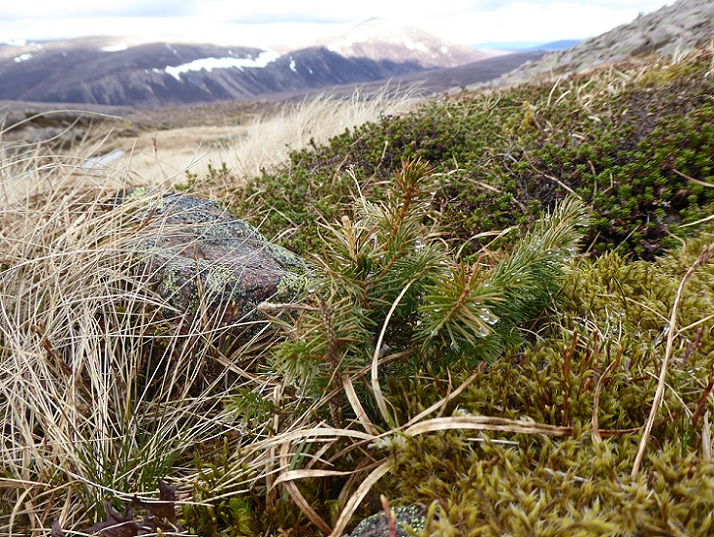
I am not a good enough botanist to tell whether this is a Sitka or Norwegian spruce but it tells a tale. I spotted it during a stravaig round the Mar Lodge estate in what is still, despite global warming, a very challenging environment for trees.
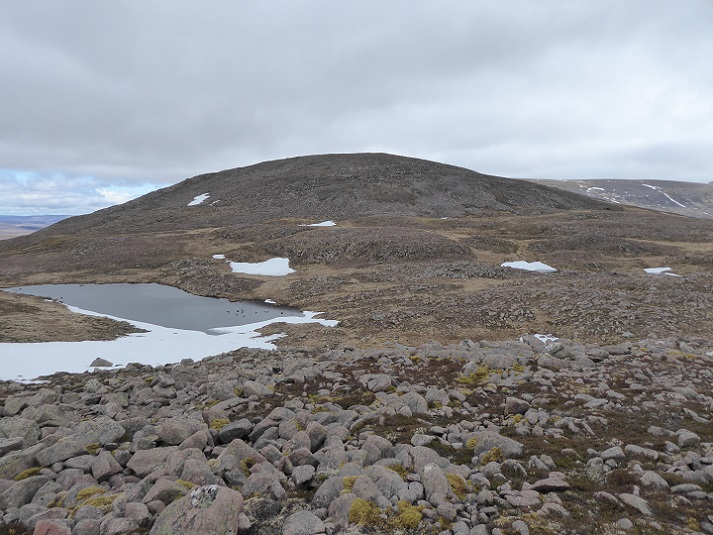
While the sapling had been browsed – two nibbled shoots are visible on its left-hand side – its bushy shape is also probably a consequence of the strong winds that blow across the plateaus in the Cairngorms.
Those winds also probably explain how the sapling got here. I would have fairly impressed if the sapling had been a Scots Pine and had been blown up across the Moine from Glen Derry c6km away but the nearest source of spruce seed I can think of is near Mar Lodge – c12km distant!
It would be wrong, however, see this sapling as a miracle. If it is was wind that blew the seed to near the summit of Beinn a’ Chaorainn Bheag – and seed can blow miles across frozen snow – it was probably one of thousands. Most of these would have ended up on stony ground or bog and never germinated. And of those that did germinate, most will have been shaded out by other vegetation or else, until recently, eaten before they were spotted by any human.
That this sapling has survived to grow as large as it has, therefore, is part of the success story on the northern half of Mar Lodge estate where, since the National Trust for Scotland has reduced deer numbers to c2 per km, trees are spreading up the hillsides.
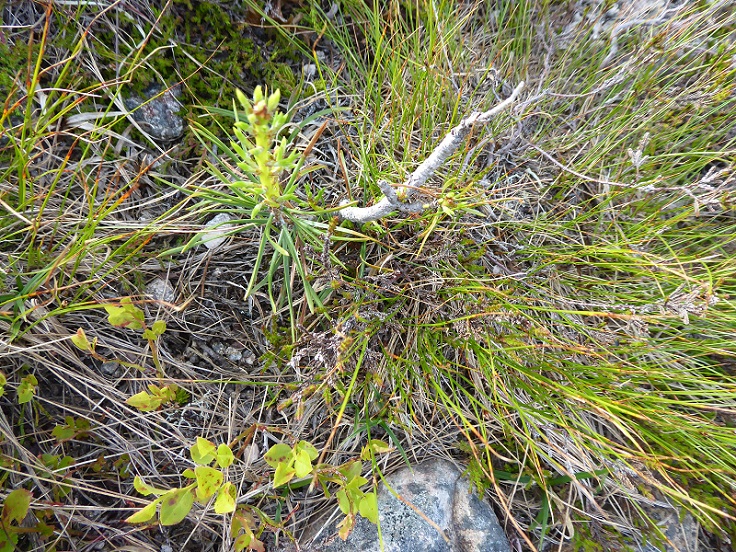
I spotted another sapling, Scots Pine this time, at almost 3000ft on Beinn a’Bhuird on Saturday. It too had been browsed. Its presence was far less of a surprise as it was only c2.5km from the old Caledonian pine trees down in Glen Quoich and there were lots of pine saplings colonising the ground alongside the path we had taken. It was just that it was the last pine sapling I spotted, a few hundred metres up the hillside from my penultimate sighting.
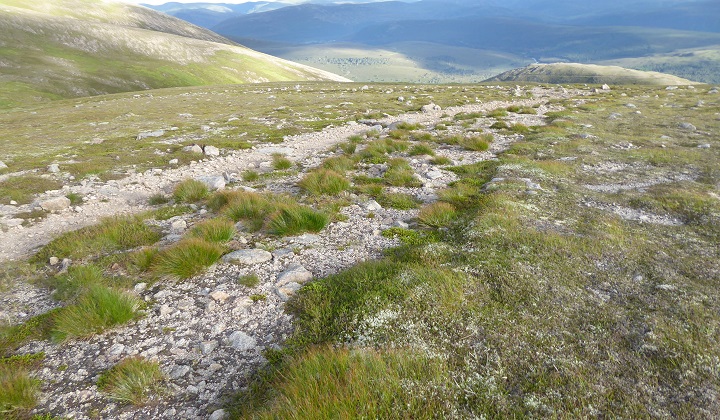
There will have been more pine saplings scattered away from the path. But the second sapling helps illustrate the fact that as you travel further away from a seed source, the fewer the seeds. This means natural regeneration takes longer. Added to which the remoter you get on this corner of the Mar Lodge estate, the harder it is for the National Trust for Scotland to prevent deer moving in from neighbouring landholdings and keep browsing pressure under control. The fact that these saplings have survived, therefore, is a testament to the work NTS is doing but is also an indication that there is more work to do.
This browsed and weather beaten spruce sapling stands as a rebuke to all those foresters and conservationists who claim we need to plant trees to restore nature. Partly because of that, I resisted the temptation to uproot it as a non-native species in the heart of the National Park. The tree gardeners include the RSPB, who have been trying to plant “missing species” just 4km away in Glen Avon on their Abernethy Estate.
This sapling stands as proof that there is no justification for the RSPB’s attempt to plant the Loch Avon basin. To my mind it was poetic justice that many of the trees they planted initially were destroyed by browsing reindeer! The lesson is if the RSPB controlled the numbers of grazing animals, as NTS are doing, all they need to do is to be patient and trees will colonise areas from which they are now missing on ground that is suited to them.
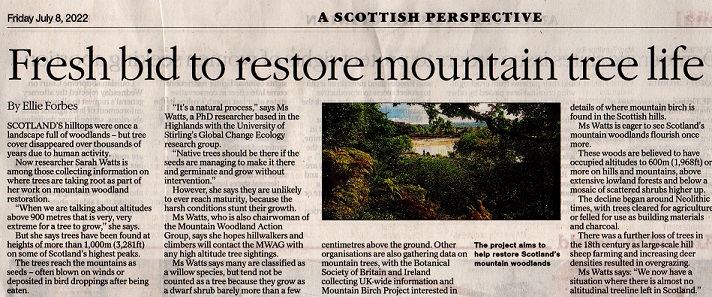
With all the pressure to plant trees, fuelled by public subsidy (see here), it was very good to see that a researcher is now asking hillwalkers and climbers to record high altitude tree sightings:
“Native trees should be there if the seeds are managing to make it there and germinate and grow without intervention”.
The RSPB, BrewDog and others who want to plant some of our most special areas should note:
“The trees reach the mountains as seeds – often blown on winds or deposited in bird droppings after being eaten”.
So why, when RSPB’s mission is to promote birds, are they ignoring the role of birds in spreading seeds? The researchers could have added that animals too, including red deer, help disperse seeds in their droppings and on their coats, .
Whether the spruce sapling on Beinn a’ Chaorainn was blown or carried doesn’t really matter. The point is that all the natural processes that enabled trees to colonise the land as the ice receded are still there, if only we gave them the chance and stopped the planting behind deer fences. Enabling natural regeneration should be at the very heart of how all land in Cairngorm National Park is managed and the spruce sapling was testament to that
Same old problem in the Highlands generally: too many sheep! We don’t need the ridiculous number of sheep in the UK! They are a nuisance where they devour young saplings. Tree planting is a nonsense! Let nature get on with it by herself.
The reason we DO need a lot of sheep , raised within enclosures appears to be completely passing this generation by. This must be rectified. Each week the media report the science confirming the vast quality of plastics and fibre filaments that are now all pervasive across the ecosytem. Plastic filaments in the soil… seeping into ground water and river systems, in fish,and crustaceans and lining the stomachs and intestines of every living thing. Plenty remarks are to be found on this blog to condemn plastic tree protection tubes…and the many plastic byproducts that cannot be recycled, or re-purposed. Forensic science relies on microscopic plastic ” fibres from clothing that fall off every moment, to clear up crime. More fibres flow out into sewage treatment works , and compromise the processes during every wash cycle.
Wool can be the solution, just as it always used to be. It is of course not so durable, but it is endlessly replaceable, and it does biodegrade. Industrialists should be seeking new ways to use it , not only for textiles but incorporated back into fertilisers and soil conditioners, and also in place of foam plastics and mineral wools for building insulation. The vital thing here is to husband sheep within defined enclosures …and maybe not so much where attempts are being made to get forests to become re-established across the over drained and burnt back and barren ecological deserts which blight so many highland grouse moors.
Doesn’t address the fact that sheep saplings!
Sorry, I meant to write: sheep devour saplings. There should be restrictions on where they wander in open countryside.
The first line mentions ” within enclosures”. My final sentence also. It might also say beyond safeguarded areas . It is perfectly correct that sheep and deer devour saplings, and this fact is reason enough to study the successes of Deer and sheep husbandry in New Zealand.
Enclosures are key to good management,they ease the snags of seasonal feeding regimes and afford real protection of native forests. Scotland could aim for this too. The economy could benefit from a revival of use of wool in the textile insulation and fertiliser trade at the same time.
I have no doubt many would be interested to a visit an area similar to the one within 250 mtrs of where I type this. What is there today is very instructive. We came here to a rocky sheep grazed open space , next to a sheep dominated bit of highland hill. We now live in a naturally self seeded and rejuvenated woodland, from which sheep and deer are excluded It has taken 20 years, and we still keep very low numbers of sheep and have marauding deer we can do little about grazing our hill- a rejuvenating native woodland – beyond the deer fence. We encouraged the vagrant deer to move across our bit of hill along flail-mowed pathways through heather scrub. Along these pathways grasses soon self seeded.Deer no longer wander at random everywhere. Dormant Tree seedlings have spouted wherever they were too lazy to go ! This a microcosm of an outcome that might be achieved more universally with thought and commitment.
Nick – Are you aware that the RSPB planting plans around Loch Avon only include montane scrub species? Similar to NTS at Mar Lodge and Wildlands Ltd on their land, who have and continue to plant montane species on their estates. RSPB, NTS and Wildlands all also plant other species such as aspen and birch at lower altitudes, by far and away the largest number and extent is on Wildlands Ltd land. All three estates have similarly low deer density on their open and high ground, the last coordinated helicopter count showed Abernethy and Wildlands ltd had <1 deer per kilometre square, whereas Mar Lodge was slightly higher, as they don't manage their whole estate for forest expansion.
In my own opinion as a resident in the National park and with an interest in ecological restoration, the three estate owners (RSPB, NTS, Wildlands) are running quite similar, highly professional and well thought through plans to restore woodland and scrub (as well as restore degraded peatlands) following centuries of human degradation. There are some differences in their approaches and these are likely because of inherent differences in the sites – e.g. the richest soils are on Wildlands ground, the most difficult internal politics lie with NTS and their purchase covenants, the RSPB are trying to expand woodland largely against the prevailing wind and with the least amount of surviving mature broadleaf trees.
I think you must know that the RSPB approach is far more similar to NTS and Wildlands than it is to Brewdog. I guess that you also know that there are some inaccuracies in your post – if not then just say and I will point them out in a separate reply.
These issues are complex, you often do great work presenting that complexity, but I feel in this case you are putting a spin on the situation. At the end of the day, all of the RSPB, NTS and Mar Lodge are friends for the environment, we are lucky to have them rather than typical Scottish landowners who would still be managing the Abernethy open ground as a grouse moor with no interest in restoring degraded habitats. They also all recognise there is some urgency to make hay while the sun shines with this work – there is funding, passion and energy on the ground and political support that means this work can happen now – that might not be the case in the future. You could be right that if left alone with only deer management these habitats can recover eventually – but how long will we need to wait? The world is in an ecological crisis and needs a helping hand now to prevent further species extinctions and to begin the healing process.
Hi Frank, I am fully aware that the RSPB are planting “montane scrub” species around Loch Avon and have written about this (see here) last year. I disagree with all three conservation landowners about the planting – now deer have been reduced they should give time to see what comes back – and have said so to each of them. The impatience to plant has led to some totally inappropriate planting. If you visit the Geldie – I will post about that in due course – montane species have been planted by the Pearls in Peril project on deep peat. RSPB’s planting plan for the Loch Avon basin allowed for planting on peat as long as it was less than 30cm deep. In my view that is totally unjustifiable. But there is another reason I mentioned the RSPB’s attempt to plant the Loch Avon basin. It is the very heart of the Cairngorms, a wild place and not somewhere that should be gardened. Different in principle from the north side of Meall a Bhuachaille which the RSPB also wanted to plant, though I think they should be more patient there too. Nick
There are thousands of hectares across the Scottish Highlands where the planting of willows and other native tree and shrub species characteristic of the montane zone would be appropriate and welcome. We could start with much of the land owned by Forestry and Land Scotland, providing they get rid of deer fencing, increase their own deer culling and tell their neighbours to also bring deer numbers down to ecologically acceptable levels. And they should do this with the full support of the Scottish Government who must by now surely realise that such action by FLS is one of the best ways to achieve climate change mitigation and biodiversity recovery objectives.
But there are some areas where such planting is inappropriate. These are the river catchments which still contain remnants of Scotland’s ancient forests. The expansion of these woodland areas should be by natural regeneration, not planting, especially on slopes that lead up to the altitudinal limits for tree and shrub growth.. The foremost area where such a policy should be applied is in the Cairngorms massif with its extensive tracts of native pinewood on the lower slopes. This massif contains the most remote and wildest land in the UK and, since the first nature conservation measures were put in place in the 1950s, the primary objective has been to expand those woodlands by natural regeneration. This is essential, not only because such a policy leads to an exceptionally beautiful transformation of the landscape, as the regenerating trees and shrubs slowly creep up towards their altitudinal limits, creating an ever evolving mosaic of new wildlife habitats, but because it is also a scientific necessity. Expanding areas of natural woodland, especially those regenerating towards altitudinal limits for tree growth, are extremely important for understanding how natural vegetation responds to climate change. The Cairngorms is the best area in the UK for studying these processes and has been a central consideration in the development of conservation policies over the last 70 years. We need these policies to continue into the future, providing a benchmark and scientific reference point which can be compared with the more interventionist approach, involving planting, which should be followed in other river catchments in the Highlands. Elsewhere most natural forest has been eliminated by centuries of cutting, burning, overgrazing and previous fluctuations in the climate.
This is why the continuing efforts of the RSPB to plant willows in the heart of the Cairngorms in Glen Avon is wrong. Instead they need to put more effort into controlling deer numbers on their own land and persuade their immediate neighbour in Glen Avon to do likewise. That is what is required, not planting. The ebb and flow of different species, according to changes in the weather and grazing pressure, is why the Cairngorms are so special and should not be subject to a large scale RSPB gardening exercise. If the RSPB want to plant in the Cairngorms there is plenty of space to do this on the adjacent land to the north, in Coire Cas. This much modified landscape, devoted to downhill ski development and other outdoor recreation activities is the ideal place for restoring montane woodland through planting, for explaining the importance of treelines to the public and politicians, and helping to secure better snow cover in winter.
All this has been explained to the RSPB many times in the last few years as they have embarked on their Cairngorms gardening exercise. Experts such as the late Adam Watson and Dick Balharry were amongst those who have spent many hours trying to convince RSPB staff that this planting was in breach of the conditions laid down when the RSPB purchased land in the Cairngorms, starting with Abernethy forest and helped by a great deal of public money. Current RSPB policy runs contrary to the policies that they followed during the first 30 years of ownership. Impatience was the only excuse offered by their senior management for this fundamental change in policy in recent years. Such arrogance and insensitivity to conservation requirements in the Cairngorms is inappropriate for such a well respected and powerful conservation organisation. The planting needs to stop, now.
A couple of comments.
1) whilst natural regeneration can be really inspiring to see, such as in Glen Quoich, planting, if done properly (right trees in the right place and all that) surely speeds up the process of returning woodland to the hills?
2) if planting is carried out by contractors rather than volunteers (I don’t know what method these landowners use) then that helps improve rural
employment, taking away one of the arguments which sporting estates often use to justify their existence.
Hi Kevin,
The trouble is there are all too few examples of the right tree in the right place, partly because what is seen as the right place is determined by prevailing orthodoxy (eg its still ok to plant trees on peat up to 30cms thick) and partly because of the forestry grants system. Related to this, there would be far more local jobs if instead of employing contractors to plants 1000s of trees in one go – who often come from outside the local area – we employed deer stalkers and shepherds to keep the numbers of grazing animals and where they graze under control. I plan a few more posts later in the summer illustrating these points.
Nick